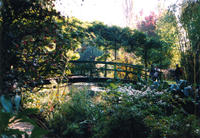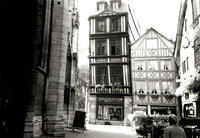

Early morning mist softens the industrial landscape. The dockyard silhouette of silos and cranes tails away at Val de Haye, where a lone column with an eagle marks Napoleons' return from exile.
The road wanders inland for a while before arriving at the crossing to La Bouille. A bright red gondola of a ferry draws you towards a village set beneath five rounded cliff tops. On top of the hill is a fortified tower now converted into someones' home, the only ramshackle building on a river bank of manicured finesse. Gradually the road climbs to a panorama of cliffs rising alternately on either bank and fields ebbing away to shades of straw. South of Duclair you are into serious fruit growing country, with apple, pear and plum trees and roadside stalls piled high with cherries. Another ferry carries you over to Jumièges, a pretty village with a wonderful ruined abbey. It is impressive because of its' age, begun in the ninth century, and also its' size. Two enormous towers at the front and a great wall behind, linked by naves and arches that retain a remarkable sense of unity. So much of the abbey stands intact, it would make a terrific backdrop to one of those 'son et lumère' spectaculars that light up the summers night.

A little further north you approach a magnificent modern bridge leading to Caudebec-en-Caux. Bands of steel stretching upto riverside towers, like two transparent pyramids suspended above the hillside. It is a long steep climb up the Pont de Brotonne, then a sweeping descent inside a barrier rail no higher than my handlebars. Got installed very reasonably at the Hôtel St. Philippe, scrubbed, fed and seated at the bar in time for the European final. Not much can happen in a place like this, one square, a bridge and a prom, but when Trézeguet scored the golden goal, a procession of tricoloured cars took off to a pounding circuit of Abba anthems with a chorus line from the balconies. Around midnight the town went back to sleep but it had known its hour of glory.
The next morning I got up improbably early and wandered around the town. Caudebec centers on a lovely church with imposing towers and a mass of coloured glass. La Sente de la Vignette takes you above the river and into a sunlit forest, and a few miles north a road leads through golden fields to the hamlet of St.Gertrude. A little church, a water mill and a few peasants tending their patch, the Restaurant des Chasseurs is a wonderful location to take lunch. West of Caudebec on a loop in the river, is Villequier home of the Musée Victor Hugo. More than a cottage but not quite a castle, it stands in a rose garden with statues and dinky outhouses you could spend all summer in as a child. Inside there is a billiard table with no pockets and an aquamarine baize. On the walls, several sketches by the author, one of a dark beguiling castle, the ancestral home of Cruella Deville. A tiny wooden staircase leads to a sequence of exquisite bedrooms that would reorient your life around sleep. I scoured the family tree for any trace of a Mule lineage. Victor Hugo would probably have bequeathed this place to the orphaned and dispossessed of the world, but I want it for my own.

Over on the left bank is La Route des Chaumières, a quiet road of thatched cottages, some pristine, others settling like comfortable chairs into a form all of their own. At l'Eglise St. Martin a sailing ship and life belt hang inside the window, the walls etched with the thoughts of ancient mariners, a local feature known as pious graffiti. Here and there castle ruins break out of the ground marking the scene of long-lost battles. The Forêt de Brotonne descends the hillside, wrapping itself around the road, then retreats at Le Vieux Port to reveal a perfect village beside the Seine.
From the crest above Le Vieux Port, the end of the idyll is in sight. Port Jérome, chemical capital of France, a complex of nuclear domes, pressure cookers and bunsen burners flaring into the sky. Two chalk headlands rise in a final display of grandeur, before the river banks fan out to mudflats and lines of pylons marching towards the sea. I cut inland at Lillebonne where a powerful Roman ampitheatre, bedded in lush grass, embraces the little terrace of the Café du Théâtre. A winding lane follows the valley out of town, past a trout stream and a sign for foie gras. There was noone in at the farm, just geese clambering out of their tumbledown house, singing for their supper. I lay down on a verge, located Foucart on the map and awaited the stopping train home.
Extract from the book, 'A Mule in Rouen-a discovery of Upper Normandy'
by Rob Silverstone
ISBN 1843861631
www.normandymule.co.uk